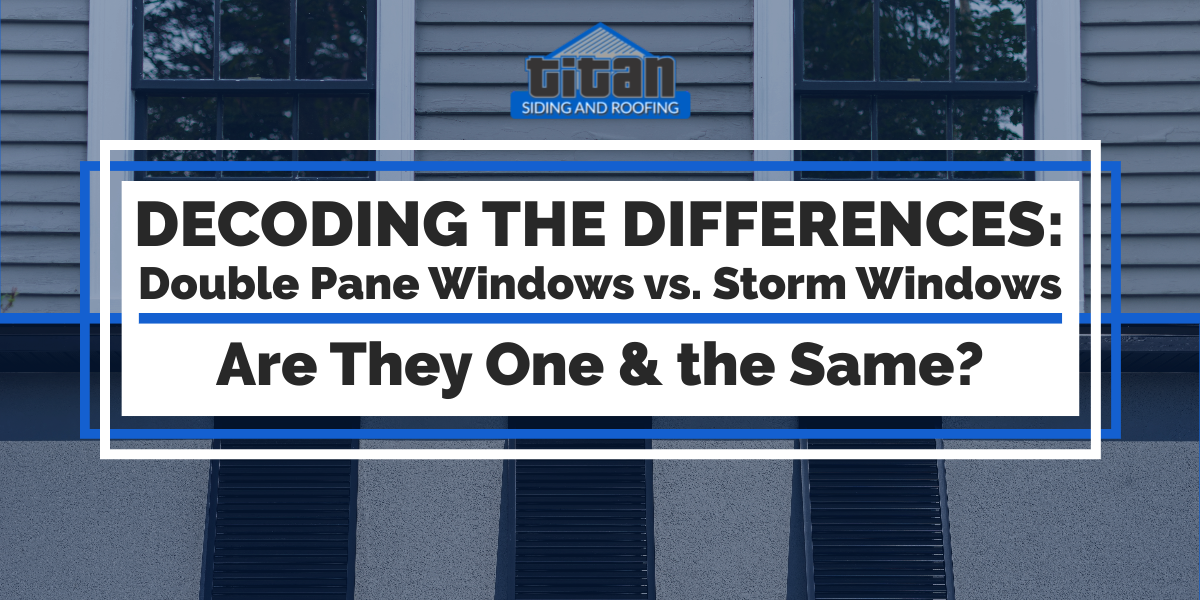When choosing the right windows for your home, it can be confusing to understand the differences between double-pane windows and storm windows. Many people mistakenly believe these terms are interchangeable, but they refer to two distinct types of windows. Here, we will decode the differences between double-pane and storm windows and determine their differences so that you can make informed decisions about the windows in your home.
Double-Pane Windows
Double-pane windows, also known as double glazing, consist of two panes of glass separated by a layer of air or gas. The primary purpose of double-pane windows is to provide better insulation and reduce heat transfer between the interior and exterior of a building.
How They’re Made

Double pane windows are manufactured using advanced techniques to create a highly insulative product. The process begins by creating two individual glass panes of a specific thickness. These panes are then cleaned and treated to remove any impurities. Next, a spacer is placed around the edges of one of the glass panes, creating a gap between the two panes. This gap is filled with either air or an insulating gas such as argon or krypton.
The glass panes and the spacer are then sealed together using a high-quality sealant. This sealing process ensures that the air or gas remains trapped between the panes, creating an insulating barrier. The sealed double-pane unit is then tested for quality to ensure optimal performance.
With the addition of the air or gas-filled gap, this manufacturing process significantly reduces the heat transfer between the interior and exterior, making double-pane windows more insulative than single-pane windows. The trapped air or gas acts as a barrier, preventing heat exchange and keeping the indoor temperature more stable. This improved insulation helps to prevent heat loss during colder months and heat gain during warmer months, resulting in greater energy efficiency and ultimately reducing heating and cooling costs.
Benefits of Double Pane Windows:
- Improved energy efficiency
- Enhanced sound insulation
- Reduced condensation
- Increased comfort in the home
- Potential savings on heating and cooling costs
- Storm Windows
On the other hand, storm windows are installed over existing windows to provide an extra layer of protection against the elements.
Storm windows are made using various methods and materials, depending on the manufacturer and the specific design. Generally, storm windows consist of a single pane of glass or a clear plastic sheet mounted on a frame. The frame is typically made of aluminum, vinyl, or wood and is designed to fit snugly over the existing window frame.
Some storm windows are manufactured to be applied from the inside of the home. These interior-mounted storm windows are designed to be easily removable and can be installed during colder seasons to improve insulation. The frame of these interior storm windows is often made of lightweight materials like aluminum or vinyl, making them easy to handle and install.
On the other hand, some storm windows are made to be applied from outside the home. These exterior-mounted storm windows are designed to provide extra protection against the elements. They are typically more robust and weather-resistant, as they need to withstand wind, rain, and snow. The frame of these exterior storm windows is often made of sturdier materials like aluminum or wood, ensuring durability and long-lasting performance.
Choosing between interior or exterior-mounted storm windows depends on various factors, such as the climate, personal preference, and the condition of the existing windows. Interior-mounted storm windows are convenient for easy installation and removal, allowing homeowners to switch them out depending on the season. On the other hand, exterior-mounted storm windows provide a permanent protective barrier and can be more effective in extreme weather conditions.
Benefits of Storm Windows:
- Increased energy efficiency by reducing air leakage
- Enhanced protection against the elements
- Added insulation for existing windows
- Improved noise reduction
- Potential savings on heating and cooling costs
- Differences and Similarities
It is clear that double-pane windows and storm windows serve different purposes, although there are some similarities between them. Both types of windows can improve energy efficiency, enhance sound insulation, and potentially reduce heating and cooling costs. However, the key distinction lies in their construction and installation.
Double-pane windows consist of two panes of glass that are permanently sealed together. In contrast, storm windows are installed as an additional layer on existing windows’ outside (or sometimes the inside). Storm windows act as a protective barrier against the elements, while double-pane windows primarily focus on providing insulation.
Conclusion
In conclusion, double-pane windows and storm windows are not the same. Understanding the differences between these two types of windows can help you decide when choosing the most suitable option for your home.
Whether you want to improve energy efficiency, enhance sound insulation, or protect against extreme weather conditions, it is essential to consider your specific needs and budget before making a final decision. Consult with a professional contractor like Titan Siding and Roofing to determine the best solution for your home in the greater Cincinnati area. If you’d like to schedule a free estimate, contact us today!






